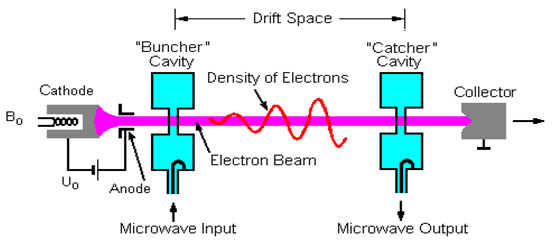Compared to TWTs, klystrons, which represent another type of velocity modulated vacuum tubes, have narrower bandwidth of operation but are capable of producing superior power. Invented by the Varian brothers of Stanford University in 1939, klystrons have been used extensively in radar equipment, telecommunications and particle accelerators.

In the basic configuration, the electrons are injected by the electron gun into an evacuated tube where they travel linearly towards the positive potential.
The input microwave signal is applied to the input cavity, modulating the electric field around it. Depending on the frequency and magnitude of the signal, the electrons passing through the cavity are accelerated or decelerated, and as a result bunches of electrons are formed in the drift space. A standing wave of bunches of the electrons is produced in the output cavity, which location in the tube is related to the transit time of the bunches at the resonant frequency of the cavities. The magnetic field of the electron beam induces a voltage across the output cavity, which gives a linearly amplified microwave signal. Multiple cavities are used to improve the gain and efficiency of the klystron amplifier.
Klystrons are capable of producing high-power microwave output both for pulsed and carrier wave (CW) applications. The CW klystrons are used for ultra-high frequency television transmission and tropospheric communications such as air traffic and marine control (1-4 GHz). They are also employed in satellite-to-ground communication (4-12 GHz). With the increase in frequency, the operational power of CW klystrons decreases from about 50 kW to 1 kW. However, the pulsed klystrons used in radars and for driving RF linear particle accelerators can produce up to a hundred megawatts of power. The combination of high power density and efficiency make klystrons, along with TWTs, the dominant technology in the microwave applications mentioned above.
Further Reading:
- Granatstein, V.L. et al. (1999) Scanning the technology : Vacuum electronics at the dawn of the twenty-first century. http://ieeexplore.ieee.org/stamp/stamp.jsp?arnumber=00757251